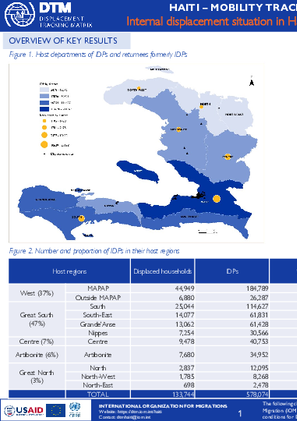-
Countries
-
Data and Analysis
-
Special Focus
-
Crisis Responses
Haiti — Key information on the internal displacement situation in Haiti — Round 7 (June 2024)

Contacter
DTM Haiti, dtmhaiti@iom.int
Langue
English
Emplacement
Haiti
Période couverte
Feb 24 2024
May 31 2024
Activité
- Mobility Tracking
- Baseline Assessment
- Site Assessment
- Village Assessment
The Round 6, published in early March 2024, indicated that 362,551 people were
internally displaced in Haiti. This new Round indicates the presence of 578,074 internally displaced people, almost 60%
more than in Round 6. This increase is due to the deterioration of the security situation observed in the MAPAP, Haiti’s
capital, between the end of February and April 2024 in particular. The increase in the number of IDPs was more
identified in provinces where it increased by 95% (compared to 15% in the MAPAP). Indeed, following the increase in
violence in the MAPAP, many people fled the capital to seek refuge in provinces.
The Great South was the region that saw the largest increase in the number of IDPs hosted there (130% more
compared to Round 6). Nearly half (47%) of IDPs in the country are located in the Great South.
The majority of IDPs in the country are hosted in provinces: 68% in provinces vs. 32% in the MAPAP
The IDPs in provinces are mainly people who fled the MAPAP: 78% of IDPs in provinces came from the MAPAP.
Artibonite, where half of the IDPs fled areas located in this department, is an exception. In all other departments of the
country, IDPs mainly came from the MAPAP.
At the national level, the majority of IDPs are hosted by host families: 80% vs 20% in sites. However, in the MAPAP,
the majority of IDPs reside in sites (61% in sites vs 39% in host families), while in provinces the opposite is true (97% in
host families vs 3% in sites). It is crucial to support host communities in provinces, particularly in the Great South, to
enable them to continue hosting IDPs; and it is important to promote social cohesion between these two population
groups. Without the resilience of host communities, the number of sites in provinces is likely to increase as has been the
case in the MAPAP. Indeed, at the beginning of the crisis, the majority of IDPs in the MAPAP were hosted by host
families: only about 2 out of 10 IDPs were in sites in 2022; this figure increased to 6 out of 10 IDPs in 2023. One of the
main reasons for this increase was the lack of resources of host communities to continue hosting IDPs and the
deterioration of social cohesion in this context.
In addition, 50,000 returnees formerly IDPs were identified, particularly in the MAPAP, in Croix-des-Bouquets (21%),
Cité Soleil (14%), Port-au-Prince (12%); in the South in Tiburon (19%); and in the Center in Sauts d’Eau (10%). It should
be noted that for the moment these returns remain very fragile and are not sustainable, particularly in the MAPAP.
